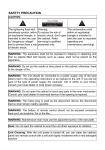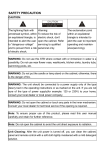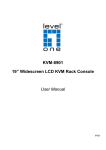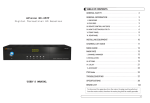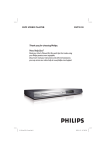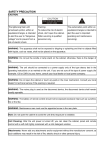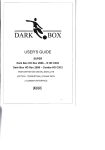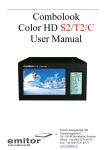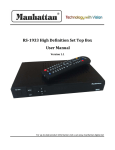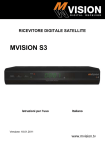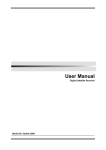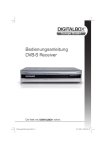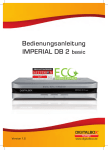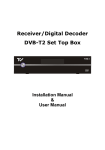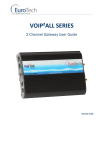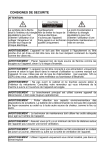Download SAFETY PRECAUTION
Transcript
SAFETY PRECAUTION CAUTION: The lightening flash with arrowhead symbol, within an equilateral triangle, is intended to alert the user to "dangerous voltage" and to prevent from a risk of electric shock. Warning: To reduce the risk of electric shock, don't open the cabinet. Refer servicing to qualified personnel only. The exclamation point within an equilateral triangle is intended to alert the user to important operating and maintenance (servicing). WARNING: The apparatus shall not be exposed to dripping or splashing and that no objects filled with liquids, such as vases, shall not be placed on the apparatus. WARNING: Do not put the candle or lamp stand on the cabinet; otherwise, there is the danger of fire. WARNING: The unit should be connected to a power supply only of the type descry bed in the operating instructions or as marked on the unit. If you are not sure of the type of power supply (for example: 120 or 230V) to your home, consult your local dealer or local power company. WARNING: Do not open the cabinet or touch any parts in the inner mechanism. Consult your local dealer for technical service if the opening is required. WARNING: The mains plug is used as the disconnect device, the disconnect device shall remain readily operable. WARNING: The battery of remote control should not be exposed excessive heat such as sunshine, fire or the like. WARNING: Maintenance man must use the appointed screw in the rear plate. Note: Do not open the cabinet to avoid the unit direct exposure to radiation. Unit Cleaning: After the unit power is turned off, you can clean the cabinet, panel and remote control with a soft cloth lightly moistened with a mild detergent solution. Attachments: Never add any attachments and/or equipment without the manufacturer consent; as such additions may result in the risk of fire, electric shock or other personal injury. Locating: Slots and openings in the cabinet are provided for ventilation to protect it from overheating. Do not block these openings or allow them to be blocked by placing the STB on a bed, sofa or other similar surface, nor should it be placed over a radiator or heat register. Power-Cord Protection: Place the power-supply cord out of the way, where it will not be walked on. Please take special attentions to cords at plugs, convenience receptacles and the point where they exit from the unit. Object and Liquid Entry: Never put objects of any kind into this STB through openings, as they may touch dangerous voltage points or short-out parts that could result in a fire or electric shock. Never spill any liquid on the STB. Note: Moisture may be formed inside the unit in the following conditions: When the unit is suddenly moved from a cold environment or an air-condition room to a warm place. Immediately after a heater has been turned on. In a steamy or very humid room. If the moisture forms inside the unit, it may not operate properly. To correct this problem, turn on the power and wait about two hours for the moisture to evaporate. Parts Replacement: When the unit parts need to be replaced, user should make sure the service technician use the replacement parts specified by the manufacturer or having the same characteristics as the original part. Unauthorized replacement may put the unit in the risk of fire, electric shock or other hazards. Safety Check: After all the maintenances and repairs are done, user is required to request the service technician to conduct the overall safety check to ensure the machine is in the proper condition. Contents Contents 1. Remote Control & Panel Description...................................................3 1.1 Front Panel Description ...................................................................................3 1.2 Rear Panel Description ....................................................................................4 1.3 Remote Control Description .............................................................................5 2. Basic Operations ....................................................................................6 2.1 2.2 2.3 2.4 2.5 2.6 2.7 2.8 2.9 2.10 2.11 2.12 2.13 2.14 2.15 2.16 2.17 2.18 2.19 2.20 2.21 2.22 2.23 2.24 2.25 2.26 2.27 2.28 2.29 2.30 2.31 2.32 2.33 2.34 2.35 2.36 2.37 2.38 2.39 2.40 2.41 2.42 Switch on STB.................................................................................................6 Standby Mode .................................................................................................6 Mute ...............................................................................................................7 Audio ..............................................................................................................7 TV/STB ...........................................................................................................7 TV/Radio.........................................................................................................7 SLEEP ............................................................................................................7 SUB................................................................................................................7 TXT.................................................................................................................8 MULTI...........................................................................................................8 P/N ...............................................................................................................8 RECALL........................................................................................................8 Channel Number ...........................................................................................9 PGUP / PGDN...............................................................................................9 SAT...............................................................................................................9 FAV +/- .........................................................................................................9 EPG..............................................................................................................9 FAV.............................................................................................................10 CH▲/▼ ......................................................................................................11 V◄/► .........................................................................................................11 OK ..............................................................................................................11 MENU .........................................................................................................12 EXIT............................................................................................................12 PAUSE........................................................................................................12 ZOOM.........................................................................................................12 EDIT ...........................................................................................................12 INFO ...........................................................................................................13 USB ............................................................................................................13 MP3 ............................................................................................................13 JPEG ..........................................................................................................13 PVR LIST....................................................................................................13 PIP (Picture in Picture).................................................................................13 A-B .............................................................................................................14 T.S..............................................................................................................14 GOTO .........................................................................................................14 ■................................................................................................................14 ●................................................................................................................15 ◄◄/►►.....................................................................................................15 ►II..............................................................................................................15 ►I◄ ...........................................................................................................15 I◄◄/►►I...................................................................................................15 LNB Short ...................................................................................................15 3. Installation .............................................................................................16 3.1 Single Search................................................................................................16 3.2 Multi Search ..................................................................................................18 1 Contents 3.3 3.4 3.5 3.6 3.7 TP Scan ........................................................................................................18 Satellite List...................................................................................................20 TP List ..........................................................................................................21 Satellite Guide...............................................................................................23 Unicable Configuration...................................................................................23 4. Channel..................................................................................................24 4.1 TV Channel List.............................................................................................24 4.1.1 4.1.2 4.1.3 4.1.4 4.1.5 4.2 4.3 4.4 4.5 4.6 4.7 Favorite .........................................................................................................................24 Move..............................................................................................................................25 Sort ................................................................................................................................25 TV Channel List Edit .....................................................................................................26 Find................................................................................................................................28 Radio Channel List ........................................................................................28 Channel Setup ..............................................................................................28 Favorite group list name ................................................................................29 Delete All ......................................................................................................30 Restore channel list and settings....................................................................30 Save channel list and settings........................................................................31 5. System Setup........................................................................................32 5.1 5.2 5.3 5.4 5.5 5.6 Language......................................................................................................32 TV System ....................................................................................................33 Time & Timer Setting .....................................................................................34 OSD Setting ..................................................................................................36 Parental Lock ................................................................................................37 Power setting ................................................................................................38 6. Tools ......................................................................................................39 6.1 6.2 6.3 6.4 Information ....................................................................................................39 Game............................................................................................................39 Factory Default..............................................................................................41 Software Upgrade..........................................................................................41 6.4.1 6.4.2 6.4.3 6.4.4 Software Upgrade.........................................................................................................42 Upgrade By Satellite .....................................................................................................42 Upgrade.........................................................................................................................43 Backup To USB ............................................................................................................43 6.5 SatcoDX Auto Programming ..........................................................................44 6.6 Smart Card....................................................................................................44 7. Media Management...............................................................................45 7.1 Media List .....................................................................................................45 7.1.1 7.1.2 7.1.3 7.1.4 7.1.5 7.1.6 7.1.7 7.1.8 All...................................................................................................................................45 Mp3................................................................................................................................48 Image ............................................................................................................................48 Video .............................................................................................................................49 Music List ......................................................................................................................49 Picture List ....................................................................................................................49 Video list........................................................................................................................50 Record list .....................................................................................................................50 7.2 Media Control................................................................................................51 7.3 Disk Information ............................................................................................52 7.4 Upgrade........................................................................................................52 8. Technical Specification ........................................................................53 2 Remote Control & Panel Description 1. Remote Control & Panel Description 1.1 Front Panel Description 1. POWER: Is used to switch between the working mode and the standby mode. 2. Display (4-Digit/7-Segment): Displays the received channel number while operating and time while in standby mode. 3. Remote Sensor: Detects the infrared signals from the remote control unit. 4. VOL+/-: To change volume to move cursor, change numbers in the menu or to change the choice. 5. MENU: To enter into the main menu and exit all menus. 6. OK: To select an item in the menu and confirm it or pop up channel list when no menu. 7. CH+/-: To change channels or for navigating and changing values in menus. 3 Remote Control & Panel Description 1.2 Rear Panel Description 1. 2. 3. 4. 5. 6. 7. 8. 9. 10. IF IN: Satellite input. RS-232: Serial Port allowing software upgrades. AUDIO: HiFi outputs for stereo set. VIDEO: CVBS video output for TV AV in. DC 0/12V: DC 0/12V output. ANT IN: Antenna input for the terrestrial antenna. TO TV: Modulator output for the connection to a TV set. AC IN: Mains input cable. POWER ON/OFF: Allows to completely switch off the receiver. IF OUT: Satellite output for cascading to other devices Note: The operation of another receiver at the same time is only possible with limited channel selection. 11. TV SCART: Output SCART for the connection to a TV set. 4 Remote Control & Panel Description 1.3 Remote Control Description 5 Basic Operations 2. Basic Operations 2.1 Switch on STB Switch the [Device’s Main Power] switch on. When the STB is first used it will display “Quick Setup” window. you will set Language, First Audio, Second Audio, LNB Power, Antenna Setup and Multi Search. ? Frequently Asked Question Q: The power of my STB is on and it is running in TV mode but the TV screen shows nothing: A: Make sure the TV set has been set to the correct video input(not the TV channels). For example, if you have connected the unit to the video1 input of the TV set then you need to select the corresponding input of the TV. Mostly it is done with the AV button of the TVs remote control unit. Q: My STB is running in TV mode but the TV screen shows nothing except one ball and “No Signal”. A: That means the channel you selected has no signal. This can be caused by several reasons: 1. The channel you selected is not from the satellite to which your dish is pointing. Select another channel. 2. The signal of current TV channel is too weak. You can try to change to other channels with a stronger signal. If the problems still exist, please consult your local dealer or installer for technical service. 3. You selected the wrong LNB type in the installation menu or your DiSEqC switch configuration is not correct. 2.2 Standby Mode 1. Press [Power] button to switch from TV/radio mode to standby mode 2. In standby mode press [Power] button again to switch back to TV/radio mode. The last active channel will be showed. 3. To switch off the STB complete press the main power button. 6 Basic Operations 2.3 Mute 1. 2. Press the [Mute] button to mute the sound. On the screen an icon will be displayed to indicate the muted sound. Press the [Mute] button again to restore the sound. 2.4 Audio 1. 2. In TV mode, press the [Audio] button to open the Audio Mode window. Select the item you want to adjust with [CH▲/▼] and change the value with [VOL◄/►]. 2.5 TV/STB Switch TV output from STB to VCR Scart. 2.6 TV/Radio In TV mode, press [TV/Radio] to switch to Radio mode. In Radio mode press [TV/Radio] again to switch back to TV mode. 2.7 SLEEP Press [SLEEP] button in TV mode to set the sleep timer. You will see “SLEEP TIME OFF / SLEEP TIME 10 / SLEEP TIME 30 / SLEEP TIME 60 / SLEEP TIME 90 / SLEEP TIME 12”. If you ser a sleep time, the system will change to standby mode after the chosen time period. 2.8 SUB Sub(Subtitle): In “OSD Setting”menu, use [SUB] to select “standard” or “Off”. If the current channel has subtitle information, it will be displayed if this function is “On”. If this function is “Off” subtitles won’t be displayed. 7 Basic Operations 2.9 TXT 1. 2. Press [TXT] button in TV mode to open the teletext page. This service is depending on the support of the channel provider. If the channel does not support teletext information, it will show “No Teletext Data” on the screen. 2.10 MULTI In TV mode, press [MULTI] to enter the “MULTI” menu. 1. In “MULTI” menu, you can choose channels’ preview window(static), starting from the current channel. Only the marked preview program is continuously playing. 2. Press [CH▲/▼ / Vol◄/►] to change the marked channel among the preview programs. 3. With the number buttons [1] ~ [9] you can directly move the highlight to the related channel. 4. With [OK] you return to full screen mode in the marked channel. 2.11 P/N In TV mode, press [P/N] button to display Mode is used to switch the display mode. 2.12 RECALL Pressing the [Recall] button allows you to toggle between the actual and the last selected channel. 8 Basic Operations 2.13 Channel Number In TV mode you can enter the channel number directly with your remote control unit and confirm the number with the OK button to change to the desired channel. 2.14 PGUP / PGDN In TV mode, press [PGUP / PGDN] to switch directly between satellites. 2.15 SAT 1. 2. In TV mode, press [SAT] button to open satellite list and select there, then press [OK] to open “TV Channel List” menu, select channel of the current. In TV mode, press [Page Up/Down] to switch directly between satellites. 2.16 FAV +/1. 2. In full screen, press [FAV +/-] keys can switch the favorite channels in current satellite channels list directly. The sequence of the switch favorite channels is following the sequence that in the current satellite channel list, not follow the sequence in the favorite group. 2.17 EPG 1. The STB supports Electronic Program Guides (EPG) to give you information about the actual programs of certain channels like event name, subtitle, description, start and finish time. This feature is depending on the service of the channel provider. Press [EPG] to open the EPG window. 9 Basic Operations 2. The [Red] button opens the detailed schedule of the marked channel. You can select an event with [CH▲/▼] and display the event’s detailed description with [OK]. 3. Press the [Green] button in the EPG menu to display the detailed information of the actual event in the selected channel. With the [Yellow] button you can program a timer with the start and finish time and date of this event. 4. Press the [Yellow] button in the EPG menu to program a timer with the actual events data. To close the EPG menu press [Exit]. 5. 2.18 FAV 1. 2. 3. 4. In TV mode press the [FAV] button to display the Favorite Group window on the screen as the picture beside shows. In the Favorite Group window you can select the desired favorite channel with [CH▲/▼] and confirm it with [OK] to switch to it. In bigger groups you can navigate with [PGUP/ PGDN]. With [VOL◄/►]. You can select different Favorite Groups. Press [Exit] to close the Favorite Group window. 10 Basic Operations ? Q: A: Frequently Asked Question Why the screen displays “No Favorite Channel” after pressing the [Favorite] button? No channels have been assigned to a Favorite Group yet. You can do this in the channel menu. 2.19 CH▲/▼ In TV/Radio mode press [CH▲/▼] to change channel. 2.20 V◄/► In TV/Radio mode, press [Vol◄/►] to adjust volume. 2.21 OK 1. 2. 3. 4. 5. 6. 7. In TV mode press [OK] button to open the Channel List window. Press the [Red] exchange screen. Press [Green] button to sort the channels by free and scrambled channels. Free channel are listed first and scrambled channels last Press [Yellow] button to open the SAT list. After selecting a satellite the channel list will be reduced to the channels of this satellite. Press [FAV] button to open FAV list. After selecting a Favorite Group the channel list will be reduced to the channels of this group. Press [Blue] button to open the Find window. You can use this feature to find channel by their names. Press [OK] to change and display the marked channel. 11 Basic Operations 2.22 MENU Press [Menu] button to enter or exit the current menu. 2.23 EXIT Press [Exit] button to exit the current menu. 2.24 PAUSE 1. 2. In playing mode, press [PAUSE], the picture will be paused, but the sound of the channel will still continues. Press [PAUSE] again, the screen’s picture will skip over to the current playing picture, and the sound of the channel will corresponding playing. 2.25 ZOOM 1. 2. 3. 4. The [Zoom] key allows you to magnify a certain area on the images and the current screen will show Press [Zoom] key again, the image will enlarge rotate as x1, x2, x4, x6, x8, x12, x16. In “x2 ~ x16” image, using [CH▲/▼ / VOL◄/►] keys to move the image center area you want to see. In zoom mode, press [Exit] to close “Zoom” window. 2.26 EDIT In TV mode, press [EDIT] button to access directly to the “TV Channel List” menu or to the “Radio Channel List” menu. 12 Basic Operations 2.27 INFO In TV mode, press [INFO] button can open information screen, in the window shows the parameters of current channel. Two dynamic bars at the bottom of the window reflect the signal intensity and signal quality of the current channel. 2.28 USB In TV mode, press [USB] button to access directly to the “Media Management” menu. 2.29 MP3 In TV mode, press [MP3] button to access directly to the “Media List-MP3” menu. 2.30 JPEG In TV mode, press [JPEG] button to access directly to the “Media List-JPEG” menu. 2.31 PVR LIST In TV mode, press [PVR LIST] button to access directly to the “Record List” menu. 2.32 PIP (Picture in Picture) In TV mode, press [PIP] button allows you to watch two channels from the same transponder at the same time. 1. Swap: press red [Swap] button to exchange the two watching channels in big picture size and smaller picture size. 13 Basic Operations 2. 3. 4. Move: press green [Move] button to move the smaller size picture to the desired position. List: press yellow [List] to show all the available channels of smaller picture. Size: press blue [size] button to zoom-in or zoom out the smaller picture. 2.33 A-B In recorded mode, during your watching, press [A-B] button to set up a starting point A, then set another point B by press [A-B] button again after a while, then it will start to playback from A to B and repeat the programs between this two points if no any interruption. 2.34 T.S. In TV mode, press [T.S.] button you will be asked to “Do you want to time shift?” menu. 2.35 GOTO When you play the recorded channels, press [Goto] button, the “Jump to” message box will pop up, input the Time and press [OK], then the receiver will back to the input time point and play the program from that point continually. (If the input time is more than the recorded time, the picture will back to last picture, please noted.) 2.36 ■ When you play a recorded program, press [■] button will stop the recorded channel playing and back to the Record Management menu. When you are recording a program, press [■] button you will be asked to “Do you want to stop record?” menu. 14 Basic Operations ● 2.37 In TV mode, press [ ] button you will be asked to “Do you want to record?” menu. ● 2.38 ◄◄/►► When you play a recorded channel, press [◄◄] button to back the program fast and Press [►►] to fast forward the program. Selection: 2x, 4x, 8x speed . 2.39 ►II When you play a current or recorded program, press [►II] will stop the program, press [►II] again will play the program continually, And Timeshift is started by this key. 2.40 ►I◄ Press [►I◄] button when you play a marked program, the screen will record to the an mark point. 2.41 I◄◄/►►I Press [I◄◄/►►I] button when you play a marked program, the screen will jump to the next mark point. 1. Jump Step Value: “1 Mins / 3 Mins / 5 Mins / 10 Mins / 15 Mins” jump. 2. Jump Step Value: Record the an mark point. 2.42 LNB Short When LNB is short, it will notify user on screen “LNB Short!” Please check your cables and connections for shorts. When the short is removed the warning message will disappear. 15 Menu Operations 3. Installation Press [Menu] in the TV/radio mode to enter the main menu. 1. Press [CH▲/▼] to select the channel item. 2. Press [OK] to enter the selected item. After selecting the installation menu you can see the window like beside. In “Installation” menu; 1. Press [CH▲/▼] to select menu items among Single Search, Multi Search, TP Scan, Satellite List, TP List, Satellite Guide and Unicable Configuration. 2. Press [OK] to enter the selected item. 3.1 Single Search After selecting “Single Search” you will see a window like beside: 1. In the “Satellite” item press [Vol◄/►] to select the satellite which you want to scan or press [OK] to open the “satellite list” to select directly with [CH▲/▼], press [OK] to confirm it. 2. LNB Configuration: Press [OK] to enter LNB configuration, you will see a window like beside: LNB Type: Press [Vol◄/►] to switch among “Standard”, “User” and “Universal” mode. For Example: If you use a Dual LNB, then you should select “User” option in “LNB Type” and set the correct frequency in LNB type. 16 Menu Operations 3. 4. 5. 6. 7. 8. 22K: Use [Vol◄/►] to switch “ON” and “Off”. The 22KHz signal is used in KU universal LNBs to change between low band and high band. ! Notice: After choosing LNB type “Universal” you cannot modify 22K. DiSEqC1.0: Use [Vol◄/►] to switch the options or press [OK] to open the DiSEqC1.0 option list to select directly with [CH▲/▼], press [OK] to confirm it. DiSEqC1.1: Use [Vol◄/►] to switch DiSEqC1.1 option or press [OK] to enter DiSEqC1.1 option to select directly with [CH▲/▼], press [OK] to confirm it. The options of this item are: Disable / CCard1 M1 Port1 / CCard1 M1 Port2 / CCard1 M1 Port3 / CCard1 M1 Port4 / CCard1 M2 Port1 / CCard1 M2 Port2 / CCard1 M2 Port3 / CCard1 M2 Port4 / CCard1 M3 Port1 / CCard1 M3 Port2 / CCard1 M3 Port3 / CCard1 M3 Port4 / CCard2 Port1 / CCard2 Port2 / CCard2 Port3 / CCard2 Port4 / CCard2 Port5 / CCard2 Port6 / CCard2 Port7 / CCard2 Port8 / CCard2 Port9 / CCard2 Port10 / CCard2 Port11 / CCard2 Port12 / CCard2 Port13 / CCard2 Port14 / CCard2 Port15 / CCard2 Port16. Positioner: Press [Vol◄/►] to select between “Off / DiSEqC1.2 / USALS”. ! Notice: When you select “DiSEqC1.2 or USALS”, “DiSEqC1.0” and “DiSEqC1.1” items will be disabled. Polarity: Press [Vol◄/►] to switch between “Auto / H / V ”. Toneburst: Press [Vol◄/►] to switch this function “On” or “Off”. DiSEqC1.0 4Port: Use [Vol◄/►] to switch the options of DiSEqC1.0. Between Disable / LNB1 / LNB2 / LNB3 / LNB4. TP Index: Use [Vol◄/►] to select the desired transponder or press [OK] to open the TP list to select directly with [CH▲/▼], press [OK] again to display the TP number where the channel can be found. FTA Only: Press [Vol◄/►] to select to scan only free channels or even scrambled channels. If you select “Yes” it will scan free channels only. Scan Channel: Press [Vol◄/►] to select to scan TV + radio channels, or just TV channels or just radio channels. Scan Mode: You can select “Auto Scan”, “Preset Scan” or “NIT Search” to blind scan preset transponders or network transponders of the selected satellite. Search: Press [OK] to start scanning. In the lower part of the window the progress of scanning and the found channels are displayed. 17 Menu Operations 3.2 Multi Search When you enter the “Multi Search” menu a window like the one beside will open. 1. In the “Satellite” item press [Vol◄/►] to select the satellite which you want to scan or press [OK] to open the “satellite list” to select directly with [CH▲/▼], and press [OK] to mark/unmark and [MENU] to finish the selection. You can select several satellites in this menu. The system will use DiSEqC1.0/1.1, DiSEqC1.2 and USALS functions to search the marked satellites and scan channels. 2. On “FTA Only” item, press [Vol◄/►] to select scanning of all channels or just scanning of free channels. If you select “Yes”, it will scan free channels only. 3. On “Scan Channel” item, press [Vol◄/►] to select the scanning range from TV + radio channels, only TV channels or only radio channels. 4. On “Scan Mode” item, you can select “Auto Scan”, “Preset Scan” or “NIT Search” to blind scan preset transponders or network transponders of the selected satellite. 5. Select “Search” and press [OK] to start scanning. In the lower part of the window the progress of scanning and the found channels are displayed. 6. Press [Menu/Exit] to cancel or finish the scanning and saving the found channels. 3.3 TP Scan When you enter “TP Scan” menu a window like the one beside will be displayed. 1. In the “Satellite” item press [Vol◄/►] to select the satellite which you want to scan or press [OK] to open the “satellite list” to select directly with [CH▲/▼], press [OK] to confirm it. 18 Menu Operations 2. TP Index: Use [Vol◄/►] to select the desired transponder or press [OK] to open the TP list to select directly with [CH▲/▼], press [OK] again to display the TP number where the channel can be found. Press [Red / Green / Yellow] key on the RCU for the related functions. ♦ When you press [Red] it will display “New TP” in “TP Index” item. You have to set the parameters of “TP Frequency”, “Symbol Rate” for this new transponder. Therefore use the number buttons of the RCU. The available range are “3000~13450MHz” and “1000~45000KS/s”. ♦ When you press [Green] a safety question will be displayed for confirmation to delete the current transponder or not. If you select “OK”, the current transponder will be deleted and the total number of transponders will be reduced. ♦ When you press [Yellow] a safety question will be displayed for confirmation to delete all transponders or not. If you select “OK”, the all transponders on current satellite will be deleted. 3. For existing transponders you also can use number buttons to modify the parameters of “TP Frequency” and “Symbol Rate” or [Vol◄/►] to change the value directly. “Polarity” and “FTA only” are used for setting scans conditions. Press [Vol◄/►] to select a different mode. On “TP Scan” item, press [OK] will open another window where you can set “Scan Mode”, “Program Type” and “NIT Search”. Press [Menu/Exit] to return to the previous menu. Press [Red] button to add a new TP. Press [Green] button to delete the current TP. Press [Yellow] button to delete all transponders on current satellite. 4. Antenna Setup: Press [OK] to enter LNB configuration, you will see a window like beside: LNB Type: Press [Vol◄/►] to switch among “Standard”, “User” and “Universal” mode. For Example: If you use a Dual LNB, then you should select “User” option in “LNB Type” and set the correct frequency in LNB type. 19 Menu Operations 5. 22K: Use [Vol◄/►] to switch “ON” and “Off”. The 22KHz signal is used in KU universal LNBs to change between low band and high band. ! Notice: After choosing LNB type “Universal” you cannot modify 22K. DiSEqC1.0: Use [Vol◄/►] to switch the options or press [OK] to open the DiSEqC1.0 option list to select directly with [CH▲/▼], press [OK] to confirm it. DiSEqC1.1: Use [Vol◄/►] to switch DiSEqC1.1 option or press [OK] to enter DiSEqC1.1 option to select directly with [CH▲/▼], press [OK] to confirm it. The options of this item are: Disable / CCard1 M1 Port1 / CCard1 M1 Port2 / CCard1 M1 Port3 / CCard1 M1 Port4 / CCard1 M2 Port1 / CCard1 M2 Port2 / CCard1 M2 Port3 / CCard1 M2 Port4 / CCard1 M3 Port1 / CCard1 M3 Port2 / CCard1 M3 Port3 / CCard1 M3 Port4 / CCard2 Port1 / CCard2 Port2 / CCard2 Port3 / CCard2 Port4 / CCard2 Port5 / CCard2 Port6 / CCard2 Port7 / CCard2 Port8 / CCard2 Port9 / CCard2 Port10 / CCard2 Port11 / CCard2 Port12 / CCard2 Port13 / CCard2 Port14 / CCard2 Port15 / CCard2 Port16. Positioner: Press [Vol◄/►] to select between “Off / DiSEqC1.2 / USALS”. ! Notice: When you select “DiSEqC1.2 or USALS”, “DiSEqC1.0” and “DiSEqC1.1” items will be disabled. Polarity: Press [Vol◄/►] to switch between “Auto / H / V ”. Toneburst: Press [Vol◄/►] to switch this function “On” or “Off”. After you completed your modification, on the “TP Scan” item, press [OK] twice to start scanning. 3.4 Satellite List When you enter the “Satellite List” menu you can see a window like the one beside: 20 Menu Operations 1. Press [Red] button to enter edit satellite menu. You can edit the satellite’s name and its longitude. 2. Press [Green] button to open the “Add satellite” window. 3. After pressing [Yellow] button you will be asked “Are you sure to delete?”. Select “OK” to delete the marked satellite. Select “Cancel” to cancel the operation. 3.5 TP List When you open the “TP List” menu you will see a window like the one beside. 1. Press [Vol◄/►] to change the marked satellite. 21 Menu Operations 2. Press [Red] button to open the “Edit TP” menu. Here you can edit the transponder’s data. 3. Press [Green] button to open the “Add TP” menu. Here you can add a new TP and setup its parameters. 4. Press [Yellow] button will open a dialog box asking you to confirm the deletion of the current TP. If you select “OK” all the related channels will be deleted. If you select “Cancel” the operation will be cancelled. 5. Pressing the [Blue] button will open a dialog box asking you to confirm the deletion of all TP on current satellite. If you select “OK”, all TP of the current satellite will be deleted. If you select “Cancel” the operation will be cancelled. 22 Menu Operations 3.6 Satellite Guide When you enter “Satellite Guide” menu, you will see the screen like beside: Here you can enter your local longitude and latitude and the satellite’s longitude. The receiver calculates the antenna’s orientation and elevation to point your antenna to the selected satellite. 1. Use the [Number] buttons to input the values of “Local Longitude”, “Local Latitude” and “Satellite Longitude”. 2. In the “Calculate” item press [OK], the receiver auto calculates the antenna’s orientation and elevation to point your antenna to the selected satellite. 3. Press [Menu / Exit] to return to the previous menu. 3.7 Unicable Configuration Here you have two way to detect the frequency of Unicable LNB: 1. Tuner: press [Vol◄/►] to tuner 1 or tuner 2. 2. Manual Config: Press [OK] and you will see below menu. Here you need to know the IF Channel and IF Frequency of the Unicable LNB you are using, then press [Vol◄/►] to choose the IF Channel and IF Frequency accordingly, then press “exit” for saving data. 3. Auto Config: just press [OK], and you will see below window, after the massage disppear, press [Vol◄/►] to choose the frequency, then "exit". 4. InstallationàSingle searchàLNB ConfigurationàLNB type Settings must be as below: LNB type: Unicable First Frequency: 9750MHz (press [Vol◄/►] to choose) Sencond Frequency: 10600MHz. (press [Vol◄/►] to choose) Save all above settings, and back to “Single Search” menu, and start to search. 23 Menu Operations 4. Channel In the channel menu: Press [CH▲/▼] to select the wanted menu item among TV Channel List, Radio Channel List, Channel setup, Favorite group list name, Delete All, Restore channel list and settings and Save channel list and settings. Press [OK] to enter the selected item. 4.1 TV Channel List If you enter the channel list menu a window like the one below will open. 1. You can move the highlighted channel with [CH▲/▼] and press [OK] to preview the highlighted program in the preview window. 2. Press [PGUP/PGDN] on the RCU to jump between the channels by pages. 3. Press [Vol◄/►] to switch satellite of the program group. 4. Press [Menu] or [Exit] buttons to enter TV playing mode. 5. The color buttons offer further functions to manage the channel list. 4.1.1 Favorite 1. Press [FAV] to open the favorite window. 2. You can select between 8 favorite groups with [CH▲/▼]. Press [OK] to assign the channel to a favorite group, press [EXIT] to exit favorite group. 3. Press [OK] again to remove the channel from the marked favorite group. 24 Menu Operations 4. Press [MENU] button you will be asked “Are you sure to save?”. Select “Yes” to save the marked favorite group. Select “No” to cancel the operation. 5. To return to the TV channel list. The channels of favorite groups are indicated with a favorite icon behind the name. 4.1.2 Move Pressing the [Red] button in the TV channel list will open another small window where you can choose between move the actual channel and swap the actual channel to the desired position, press [OK] to confirm it. a) Move 1. Press [Red] button to show a moving icon behind the channel name. 2. Move the channel to the desired position with [CH▲/▼]. Press [OK] to confirm the position. b) Swap 1. Press [Green] button to show a moving icon behind the channel name. 2. Move the channel to the desired position with [CH▲/▼]. Press [OK], then the selected channel will exchange the postions with the channel name on this position immediately. 4.1.3 Sort Press [Green] to open the sort window. Press [CH▲/▼] to select and [OK] to confirm your choice. The ways of sorting are: ♦ Default: Sort channel factory default. ♦ FTA/CAS: Sort channel by free and scrambled sequence. Free channels will be listed first and scrambled channels behind in the channel list. ♦ Lock: Unlocked channels are listed first end locked channels at the end. 25 Menu Operations ♦ ♦ Name(A-Z): Sorting in Alphabetical order, ignoring “$” symbol. Name(Z-A): Sorting in Alphabetical order, ignoring “$” symbol. 4.1.4 TV Channel List Edit After pressing the [Yellow] button a window for entering the password will open. The default password is “0000”. You can delete, skip, lock and edit the channel. Press [MENU] to leave the channel editing. The system will ask you to confirm the saving of the changes you made. 4.1.4.1 Delete In channel edit menu press [Red] button will open another window where you can choose between delete one channel and delete all channel. ♦ Del One Press [Red] button to mark a channel for deleting. Marked channel will be deleted after you confirm to save the changes when you leave this menu. ♦ Del All a) Press [Green] button to show a deleting icon behind all channel name. b) Press [MENU] button you will be asked “Are you sure to save?”. Select “OK” to delete all channel. Select “Cancel” to cancel the operation. 4.1.4.2 Skip In channel edit menu, press [Green] button to place a skip icon behind the name of the highlighted channel. Marked channels will be skipped when you change channels in TV mode after you confirm to save the changes when you leave this menu. 4.1.4.3 Lock In channel edit menu, press [Yellow] button to place a lock icon behind the name of the highlighted channel. Marked channels will be locked and displayed only after password has been entered if you confirm to save the changes when you leave this menu. 26 Menu Operations 4.1.4.4 Edit Pressing the [Blue] button in the TV channel list edit menu will open another window where you can choose between edit the actual channel and create a new channel. ♦ Edit Press [Red] button to edit the channel. Ø Selecting the name item with [OK] will display a button pad to show you how to edit the channel name. Ø On the “Video PID”, “Audio PID” and “PCR PID” items you can input numbers to modify the item’s value. Ø After modification select “Save” and press [OK] button to save the modified values and exit “Edit” mode. Or select “Exit” and press [OK] to leave edit mode without saving the modifications. ♦ Create Press [Green] button to open the create channel window. 1. Press [OK] on the “Satellite” item to display the satellite list. You can select the satellite for which you want to create a new channel. 2. With marked “TP Index” item press [OK] to display TP list, use [CH▲/▼] to select for which you want to create a new channel. Press [OK] to display the TP number where the channel can be found. The next three items will show the related parameters. 3. Highlight the “Name” item and press [OK] to display the button pad and edit the new channel’s name. In “Video PID”, “Audio PID” and “PCR PID” items you can enter the numbers directly to set these parameters of the new channel. 27 Menu Operations 4. After modification select “Save” and press [OK] to save the new channel and leave the edit mode. Select “Exit” and press [OK] to exit the edit mode without saving the new channel. 4.1.5 Find 1. 2. Press [Blue] button to open the “Find” window like showed beside. Press [CH▲/▼] / [Vol◄/►] to select the leading character of the channel name and press [OK] to confirm it. After entering the character(s) highlight “OK” in the window and press [OK] on the RCU. 3. Press [Exit] button to close the find window and brings you back to the channel list. 4.2 Radio Channel List Basically the operation of “Radio Channel List” is same as “TV Channel List”, except that in the small channel window the radio Logo will be displayed. 4.3 Channel Setup When you enter the “Channel Setup” menu you will see a screen like beside: 1. Startup Channel: Press [OK] to enter “Startup Channel” menu to see the screen like showed beside: ♦ If you set of “Boot on Channel” to “On” you can edit the following two items. If the setting is “Off” the box always starts with the channel that was running when the box has been switched off. 28 Menu Operations ♦ 2. 3. 4. On the “Mode” item you can select either “TV channel” or “Radio channel”. ♦ On “Startup Channel” item you can open the channel list by pressing [OK]. Then you can select the channel of you choice. Press [OK] again to confirm. Channel Play type: Use [CH▲/▼] to select, press [OK] to enter “Channel Play Type” menu. Here you can select the “playing channels” as “All”, “Free” or “Scrambled” with [Vol◄/►]. If you select “Free” then all scrambled channels will be skipped when you change channels with [Vol◄/►]. Press [Exit] to leave the “Channel Setup” menu. 4.4 Favorite group list name When you enter “Favorite group list name” menu with 8 favorite group will be displayed, press [OK] on the RCU to rename favorite group. Use [CH▲/▼] / [Vol◄/►] to select character, press [OK] to confirm it. After modification select “OK” of button bar and press [OK] on the RCU to rename the favorite group name and leave the edit mode. Press [Exit] on the RCU to exit the edit mode without saving the favorite group name. 29 Menu Operations 4.5 Delete All To delete all channels: 1. Enter the password. The default password is “0000”. 2. After entering the password correct a safety question will show up where you have to confirm first 3. Select “OK” to delete all channels or “Cancel” to cancel the operation and confirm with [OK]. 4. In step 1 and step 2, pressing [Menu] will exit the function directly without saving. ? Frequently Asked Question Q: IF I incautiously delete all channels, what should I do? A: there are two ways to restore: Ø To research all channels in the “Installation” menu. Ø Use “Factory Default” function to restore all channels in the “Tools” menu. 4.6 Restore channel list and settings To restore channel list and settings. 1. Enter the password. The default password is “0000”. 2. After entering the password correct a safety question will show up where you have to confirm first. 3. Select “OK”, press [OK] to restore the last backup channel list, the current channel list will be erased. Select “Cancel” press [OK] to cancel the operation. 30 Menu Operations 4.7 Save channel list and settings To save channel list and settings. 1. Enter the password. The default password is “0000”. 2. After entering the password correct a safety question will show up where you have to confirm first. 3. Select “OK”, press [OK] to save current channel list to backup channel list. Select “Cancel” press [OK] to cancel the operation. 31 Menu Operations 5. System Setup When you open the “System Setup” menu a window like the one beside will be opened. In “System Setup” menu: 1. Press [CH▲/▼] to select menu items among Language, TV System, Time & Timer setting, OSD Setting, Parental Lock and Power setting. 2. Press [OK] to open the selected item. 5.1 Language After selecting the “Language” menu you will see a window like beside: 1. Menu Language: Press [Vol◄/►] to select languages. The selection of language include: English, German, French, Spanish, Italian, Portuguese, Turkish, Polish, Russian, Danish, Greek, Hungarian, Arabic, Farsi and Dutch. 2. First Audio: Some channels offer more than one audio language. This function allows you to set the preferred audio language for those channels. If a channel offers the same audio language as the “First Audio” you set the system will play this audio language as default. If the channel does not offer this audio language then the system will compare the offered languages with the second audio language. The selections of audio language include: English, German, French, Spanish, Italian, Portuguese, Turkish, Polish, Russian, Danish, Greek, Hungarian, Arabic, Farsi and Dutch. 3. Second Audio: If the channel has no audio language that corresponds with “First Audio” but with “Second Audio” the system will play the second audio language as default. If no audio language corresponds with the “Second Audio” then the default language of the current channel will be played instead. The selections of audio language include: English, German, 32 Menu Operations 4. 5. 6. French, Spanish, Italian, Portuguese, Turkish, Polish, Russian, Danish, Greek, Hungarian, Arabic, Farsi and Dutch. Subtitle Language: In “OSD Setting”menu, use [Vol◄/►] to select “On” or “Off”. If the current channel has subtitle information, it will be displayed if this function is “On”. If this function is “Off” subtitles won’t be displayed. The selections of subtitle language include: English, German, French, Spanish, Italian, Portuguese, Turkish, Polish, Russian, Danish, Greek, Hungarian, Arabic, Farsi and Dutch. Teletext: Press [Text] button in TV mode to open the teletext page. This service is depending on the support of the channel provider. If the channel does not support teletext information, it will show “No Teletext Data” on the screen. The selections of teletext language include: English, German, French, Spanish, Italian, Portuguese, Turkish, Polish, Russian, Danish, Greek, Hungarian, Arabic, Farsi and Dutch. Press [Menu/Exit] to return back from “Language” menu. 5.2 TV System When you enter the “TV System” menu you will see the screen like below: 1. Display Mode is used to switch the display mode. You can select from Auto / PAL / PAL-M / PAL-N / NTSC3.58 / NTSC4.43. Press [Vol◄/►] to switch the desired mode. 2. Aspect Mode is used to switch the screen aspect ratio mode. You can select the needed mode from Auto / 4:3 PS / 4:3 LB / 16:9 with [Vol◄/►]. 3. Video output is use for switching the screen aspect ratio mode. Now we provide below options: CVBS / CVBS + RGB / CVBS + S-Video. You can press [Vol◄/►] key to select each mode circularly. 4. RF System is use for switching the screen aspect ratio mode. Now we provide below options: PAL-BG / PAL-I / PAL-DK / NTSC-M. You can press [VOL◄/►] key to select each mode circularly. 33 Menu Operations 5. 6. RF Channel is use for switching the screen aspect ratio mode. Now we provide below options: 21-69. You can press [VOL◄/►] key to select each mode circularly. Press [Menu/Exit] to return to the previous menu. 5.3 Time & Timer Setting When you enter “Time & Timer Setting” a menu with this 3 items will be opened. 1. Timer: Select “Timer” item and press [OK] to enter the “Timer” menu. You can press [CH▲/▼] to select item. ♦ The current time will be displayed in the first column. If the current time is incorrect, please modify it with the [Number] buttons. ♦ Timer Number: You can press [Vol◄/►] to switch the timer number. There are totally 8 timers. ♦ Timer Mode: Select how often the timer is running: Once, Daily, Weekly, Monthly and Yearly, or switch the timer to off. ♦ Timer Service: Select between TV Channel, Radio Channel and Message. ♦ When you select “TV Channel / Radio Channel”(timer setting for channel change and Wakeup channel / date) then you have further options you need to set: Ø Wakeup Channel: Press [OK] to enter the channel list, and select the channel you want to see with [CH▲/▼], press [OK] to confirm it. Ø Wakeup Date: Use number buttons to input your wakeup date. Ø On Time: Use number buttons to input your wakeup time. If date and time are reached then no matter if the system is in standby mode or in playing mode, it will automatically switch to the channel you set and start to play. 34 Menu Operations Ø 2. Duration: Here you can set the time you want to see or play this channel. When the time is reached, whenever the system is in standby mode or playing a channel, the system will automatically switch to the channel you select and play the channel within the duration time you set. The minmum duration unit is one minute. After the duration time, the system will automatically switch to Standby mode. ♦ When you select “Message”(reminding message) option in “Timer Service” then you can enter additional data: Ø Wakeup Message: Press [Vol◄/►] to select the category Ø of the wakeup message from Birthday, Anniversary and General. Ø Wakeup Date: Use the [Number] buttons to input your wakeup date. Ø On Time: Use the [Number] buttons to input your wakeup time. If date and time are reached, no matter if the system is in standby mode or in playing mode, it will automatically show a reminding message. The message will be displayed on the screen until you press [Exit] to close it. Ø Duration: Here you can set the time you want to see or play this channel. When the time is reached, whenever the system is in standby mode or playing a channel, the system will automatically switch to the channel you select and play the channel within the duration time you set. The minmum duration unit is one minute. After the duration time, the system will automatically switch to Standby mode. ♦ Press [Exit] to leave the “Timer” menu. Local Time Setting: When you select “Local Time Setting” and press [OK] then you will see a window like the one beside: ♦ GMT Usage: This item is used to set the time by using the time signal from the satellite. Press [Vol◄/►] to change the setting. 35 Menu Operations ♦ 3. The “GMT Offset” item is only available when “GMT Usage” is set to “On”. Press [Vol◄/►] to set the “GMT Offset” value. With every time you press the button the time offset will be increased/decreased by half an hour. ♦ Summer: Press [Vol◄/►] to switch this function “On” or “Off”. ♦ “Date” and “Time” items are only available when the “GMT Usage” is set to “Off”. Press [Vol◄/►] to select one item and use number buttons to input time and date directly. ♦ Time Display: Press [Vol◄/►] to switch this function “On” or “Off”. NOTE: If the current channel provides the correct time information, you will see the current time after you entered “Local Time Setting” menu. If the channel doesn’t provide time information, you have to input the date and time information manually. The most channels support the time signal. ♦ Press [Exit] to leave the “Time” menu. Sleep Timer: Select “Sleep Timer” item and press [OK] to set the sleep timer. You will see “Sleep timer OFF / Sleep timer 10 / Sleep timer 30 / Sleep timer 60 / Sleep timer 90 / Sleep timer 120”. If you set a sleep time, the system will change to standby mode after the chosen time period. 5.4 OSD Setting When you select “OSD Setting” you will see a screen like beside: 1. Subtitle Display: Press [Vol◄/►] to select “Off”, “Standard” or “Teletext Subtitle”. If the current channel has subtitle information, it will be displayed if this function is “Standard” or “Teletext Subtitle”. If this function is “Off” subtitles won’t be displayed. 2. OSD Timeout: This setting determines the duration the info window is displayed on the screen when you change channels. Press [Vol◄/►] to set the time between 1 to 10 seconds. 3. Position: Press [Vol◄/►] select the position between top and bottom. 36 Menu Operations 4. 5. 6. OSD Transparency: With this parameter you can set the transparency of the menus. Press [Vol◄/►] select the value between 10%, 20%, 30%, 40% and “Off”(means no transparency function). Load OSD Setting Default: If you want to reset your OSD settings to the default settings then select this item and press [OK]. Press [Exit] button to leave the “OSD Setting” menu. 5.5 Parental Lock You can set a password for anyone who wishes to operate the “Installation” menu. You can also set the password to lock channels. Below you find how to set and change the password. 1. On “Parental Lock” press [OK] to open a dialogue box and input the password. After you entered the correct password, you will see a screen like beside: 2. Menu Lock: If Menu Lock is set to “Yes” then you need to enter the password every time you want to open the menu. If set to “No” then you can open the menu without entering the password first. 3. Channel Lock: If set to “Yes” then you need to enter the password before you can see those channels which have been marked as locked channels in the channel menu. If set to “No” then even those channels can be selected without entering the password first. 4. New Password: Here you can change the existing password. You should do this after you set up the receiver the first time and every time when you think that your password is known by unauthorized persons. To change the password enter the new password in the “New Password” item and repeat the same one in the “Confirm Password” item. If the passwords are not identically then you will see a warning message. If you entered the same new password in both fields then you will see the message “Saving Data, Please Wait…”. From now on you need to use the new password to open locked menus or locked channels. 37 Menu Operations 5. NOTE: The default password is 0000. Press [Exit] to leave the “Parental Lock” menu. 5.6 Power setting When you select this option, you will see a screen like beside: LNB Power: If your receiver is connected to the LNB directly then you need to set the LNB Power to “On”. If your receiver is connected to a multi switch (SMATV signal distribution system) then it may be that you don’t need to provide the power to the LNB. But since this is depending on the kind of installed distribution system we recommend you to contact your installer or to refer to the user manual of this system to get the correct information. You also just can change this setting and check if you still can receive the channels. If the LNB Power is off and you still can see all channels then we recommend this setting. 38 Menu Operations 6. Tools When you enter to “Tools” menu, you will see a screen like beside: In “Tools” menu: 1. Press [CH▲/▼] to select the wanted item among Information, Quick Setup, Game, Factory Default, Software Upgrade, SatcoDX Auto Programming Smart and Smart Card. 2. Press [OK] to enter the selected item. 6.1 Information 1. 2. When you select the “Information” menu you will see a screen like beside. The screen displays data about the current channel. Press [Exit] button to leave the information display. 6.2 Game When you enter “Game” menu, you will see three games include Tetris, Snake and Othello. 39 Menu Operations Basic operation statement: 1. Tetris Ø Mark “Setup” and press [Vol◄/►] to select the level (speed). Ø Mark “Start” and press [OK] to start the game. Ø Mark “Cancel” and press [OK] to leave the game. Ø Play the game: ♦ Press [Vol◄/►] to move the block left or right ♦ Press [Channel Up] to rotate the block clockwise ♦ Press [Channel Down] to drop the block faster ♦ Press [OK] to Pause/Play the game ♦ Press [Exit] to leave the game and return to the game menu. 2. Snake Ø Mark “Setup” and press [Vol◄/►] to select the level (speed). Ø Mark “Start” and press [OK] to start the game. Ø Mark “Cancel” and press [OK] to leave the game. Ø Play the game: ♦ Press [Vol◄/► / CH▲/▼] to guide the snake to the red blocks. Every block you ate increases the length of the snake. If the snake runs against a wall or against itself then it dies. ♦ Press [OK] to Pause/Play the game ♦ Press [Exit] to quit the game and return to the game menu. 3. Othello Ø Mark “Setup” and press [Vol◄/►] to select the game level(degree of difficulty). Ø Mark “Start” and press [OK] to start the game. 40 Menu Operations Ø Mark “Cancel” and press [OK] to leave the game. Ø Play the game: ♦ Press [Vol◄/► / CH▲/▼] to position the round mark. ♦ Press [OK] to set your stone. ♦ Press [Exit] to quit the game and return to the game menu. 6.3 Factory Default When you press [OK] on the “Factory Default” item: 1. A dialogue box will occur where you need to enter the password. 2. After you input the correct password a warning message will be displayed like the one beside. 3. If you select “Yes” then all changes you made will be reset to default values. Make sure you really want to do this! 4. Press [Exit] in both steps will close the window without resetting the receiver. 6.4 Software Upgrade When you enter to “Software Upgrade” menu, you will see a screen like beside: 1. Press [CH▲/▼] to select the wanted item among Software Upgrade, Upgrade By Satellite, Upgrade By USB and Backup To USB. 2. Press [OK] to enter the selected item. 41 Menu Operations 6.4.1 Software Upgrade 1. This function allows you to upgrade the software of the receiver. This can be done from PC to receiver or from a master receiver to a slave receiver. 2. Connect master receiver or PC to the slave receiver via serial interface (0-Modem cable). Enter the “Software Upgrade” menu of the master receiver and press [Vol◄/►] to change the upgrade mode. Upgrade modes include: All code / Main code / CAS-data / Script GUI / Radio Back / default DB / Userdb. 3. Switch on the slave receiver. 4. Mark “Start” on the master reeciver and press [OK] to start upgrade. Wait until the display on the front panel shows “-END”. Then switch off the receiver and on again. Now the new software is used. 5. Press [MENU] to save the setting without upgrade. 6.4.2 Upgrade By Satellite This function can upgrade the software of your receiver through data sent by a satellite. At the moment we offer satellite updates only through ASTRA1 and Hotbird satellites. 1. Select the satellite and TP or input the TP value and download PID. 2. Then mark “Start” and press [Enter] to begin the download of the upgrade. This may need up to 60 minutes. Therefore we suggest using of this function only if you don’t intent to watch TV during this time. 42 Menu Operations 6.4.3 Upgrade This option allows updating the software of the receiver with the received data from a USB memory device. To do it, connect a USB memory device to the receiver and accede to this menu option. The last software version to be loaded must be placed at the root path of your USB device. 1. Update file: Select with [Vol◄/►], the name of the file to be choosed. 2. Select “Start” and press [OK]. An alert message appears indicating not to take out the memory device during the loading process. 3. Once the file has been loaded, it requires the conformity to end the upgrading process, writing into the receiver “Are you sure to burn flash ?”. Press [OK] to upgrade the receiver. In case during the reading of the file, it is corrupted or it would be a not appropriated for this model of receiver, an alert message would appear “Error reading the USB disk”. 4. After pressing [OK] the receiver will write into the Flash memory, and it will reboot to end the upgrading process. NOTE: 1. USB Upgrade menu will be gray when no USB device is pluged. 2. The upgrade file is the binary file, *.bin. Only the files, which extend name is bin, would be displayed. User need put the upgrade file under root of USB card. 6.4.4 Backup To USB Back up the software and data fo the receiver to external hard drives. 43 Menu Operations 6.5 SatcoDX Auto Programming This function is using the tables of the SatcoDX websites to update your channel and satellite lists. You need a special application which is available on the CD-ROM of the Tele-Satellite magazine. Install this software on your PC first. 1. Start the SatcoDX application on your PC. 2. Select “SatcoDX Auto Programming” item from the “Tools” menu and press [OK]. The screen will show the message “OK to Proceed”. 3. Press [OK] again and you will see the message “Ready to Download”. 4. In the PC application set the Baud Rate to 115200 and start the download procedure. ! Caution: The new download channels will delete the original channels list. Please be careful before using it. 6.6 Smart Card This function is used to receive scrambled digital satellite channels. 1. Preparing To be able to receive scrambled digital satellite channels you need a Smart card from the Service Provider of your choice. Only free to air channels are available without the Smart card. Insert the Smart card to the CA slot. This will give you access to scrambled channels. 2. Check Manager Select “Smart Card” menu, then receiver detects and shows the CA system name which you are using. The Smart card may also provide access to special menus not described in this manual. If so, please follow the instructions from the Service Provider. 44 Menu Operations 7. Media Management When you enter to “Media Management” menu, you will see a screen like beside: In “Media Management” menu: 1. Press [CH▲/▼] to select the Media List, Media Control, Disk Information and Upgrade. 2. Press [OK] to enter the selected item. 7.1 Media List If you enter the Media List menu a window like the one below will open. 1. Press [Vol◄/►] select the all, mp3, image, video, music list, picture list, video list, Record list. 2. You can move the highlighted Record with [CH▲/▼] to preview the highlighted program in the preview window. 3. Press [PGUP/PGDN] on the RCU to jump between the channels by pages. 4. Press [Menu] or [Exit] buttons to enter TV playing mode. 5. The color buttons offer further functions to manage. 7.1.1 All [Edit] Press [Red] button to open the “Edit” window like showed beside. The color buttons offer further functions to manage. 45 Menu Operations 1. ♦ Rename Press [Red] button to open the “Rename” window like showed beside. Press [CH▲/▼] / [Vol◄/►] to select the leading character of the channel name and press [OK] to confirm it. ♦ After entering the character(s) highlight “OK” in the window and press [OK] on the RCU. ♦ Press [Exit] button to close the find window and brings you back to the Record list. 2. Delete In all edit menu press [Green] button will open another window where you can choose between delete one and delete all. ♦ Del One Press [Red] button to mark a “mp3 / image / video”for deleting. Marked “mp3 / image / video” will be deleted after you confirm to save the changes when you leave this menu. ♦ Del All a) Press [Green] button to show a deleting icon behind all “mp3 / image / video” name. b) Press [MENU] button you will be asked “Are you sure to save?”. Select “OK” to delete all “mp3 / image / video”. Select “Cancel” to cancel the operation. 3. Move ♦ Press [Yellow] button to show a moving icon behind the “mp3 / image / video / folder” name. ♦ Move the “mp3 / image / video / folder” to the desired folder list with [CH▲/▼]. Press [OK] to confirm the position. 46 Menu Operations 4. ♦ ♦ ♦ Folder Press [Blue] button to open the “New Folder” window like showed beside. Press [CH▲/▼] / [Vol◄/►] to select the leading character of the folder name and press [OK] to confirm it. After entering the character(s) highlight “OK” in the window and press [OK] on the RCU. Press [Exit] button to close the find window and brings you back to the all list. [Add] In all menu press [Green] button will open another window where you can choose between add one and add all. ♦ Add One Press [Red] button to mark a “mp3 / image / video”for add. Marked “mp3 / image / video” will be add after you confirm to save the changes when you leave this menu. ♦ Add All a) Press [Green] button to show a add icon behind all “mp3 / image / video” name. b) Press [MENU] button you will be asked “Are you sure to save?”. Select “OK” to add all “mp3 / image / video”. Select “Cancel” to cancel the operation. [Find] Press [Blue] button to open the “Find” window like showed beside. Press [CH▲/▼] / [Vol◄/►] to select the leading character of the channel name and press [OK] to confirm it. 47 Menu Operations After entering the character(s) highlight “OK” in the window and press [OK] on the RCU. Press [Exit] button to close the find window and brings you back to the all list. [play] The play offer further functions to manage. If you enter the play menu a window like the one below will open. The color buttons offer further functions to manage the channel list. Red: When you play music program, press [Red] will stop the program, press [Red] again will play the program continually. Green: When you play music program, press [Green] button to back the program fast. Yellow: When you play music program, press [Yellow] button to fast forward the program. Blue: Change play mode by [Blue] Key, and play mode include: Sequential / Random / Single repeat / all repeat. Press [Exit] to return to the previous menu. 7.1.2 Mp3 Basically the operation of “mp3” is same as “all”. 7.1.3 Image Basically the operation of “image” is same as “all”, except that in the Yellow buttons offer further functions to manage. In image menu press [Yellow] button will open another window. press [OK] to set the image as background. Select “Cancel” press [OK] to cancel the operation. 48 Menu Operations 7.1.4 Video Basically the operation of “video” is same as “all”. 7.1.5 Music List The color buttons offer further functions to manage. [Delete] In media list menu press [Red] button will open another window where you can choose between add one image and add all image. ♦ Del One Press [Red] button to mark a image for add. Marked image will be add after you confirm to save the changes when you leave this menu. ♦ Del All a) Press [Green] button to show a add icon behind all image name. b) Press [MENU] button you will be asked “Are you sure to save?”. Select “OK” to add all image. Select “Cancel” to cancel the operation. [Find] Basically the operation of “Music List à Find” is same as “all à Find ”. 7.1.6 Picture List Basically the operation of “Picture List” is same as “Music List”, except that in the Yellow (Setup) buttons offer further functions to manage. Press [Yellow] button to open the “Serup” window. Select the item you want to adjust with [CH▲/▼] and change the value with [VOL◄/►] Size: Full and Real. Time: 0 Sec, 1 Sec, 2 Sec, 3 Sec, 4 Sec, 5 Sec, 6 Sec, 7 Sec, 8 Sec and 9 Sec. Repeat: On and Off. Effect: Normal, Shutters, Brush, Slide, Random and Fade. Mp3: On and Off. 49 Menu Operations 7.1.7 Video list Basically the operation of “Video List” is same as “Music List”. 7.1.8 Record list If you enter the Record list menu a window like the one below will open. The color buttons offer further functions to manage the channel list. [Rename] 1. Press [Red] button to open the “Rename” window like showed beside. Press [CH▲/▼] / [Vol◄/►] to select the leading character of the channel name and press [OK] to confirm it. 2. After entering the character(s) highlight “OK” in the window and press [OK] on the RCU. 3. Press [Exit] button to close the find window and brings you back to the Record list. [Lock] In channel Record menu, press [Green] button to place a lock icon behind the name of the highlighted Record. Marked Records will be locked and displayed only after password has been entered if you confirm to save the changes when you leave this menu. 50 Menu Operations [Delete] Press [Yellow] button to mark a channel for deleting. Marked Record will be deleted after you confirm to save the changes when you leave this menu. [Del All] 1. Press [Blue] button to show a deleting icon behind all Record name. 2. Press [MENU/EXIT] button you will be asked “Are you sure to save?”. Select “OK” to delete all Record. Select “Cancel” to cancel the operation. 7.2 Media Control 1. Reserved TMS Size: Press [Vol◄/►] to switch between “0 MB / 200 MB and 500 MB”. Select “MENU / EXIT”, press [MENU / EXIT] to reset to make tms size valid now. Select “Cancel” press [OK] to cancel the operation. 2. Jump Step Value: Press [Vol◄/►] to switch between “1 mins / 3 Mins / 5 Mins / 10 Mins / 15 Mins”. The value control the step of I◄◄/►►I operation. 3. Record Type: Press [Vol◄/►] to switch between “TS and PS”. 4. Fotmat Disk: If you want to delete the hard disk totally, you can do it with the [OK] Button Format and the hard disk will be completely erased. Caution: This process will delete also saves you have made with Backup tools. 51 Menu Operations 7.3 Disk Information 1. 2. When you select the “Disk Information” menu you will see a screen like beside. The screen displays data about the current HDD. Press [Exit] button to leave the information display. 7.4 Upgrade Basically the operation of “Upgrade” is same as “6.5.3”. 52 Technical Specification 8. Technical Specification VIDEO Decoding Bit rate Output Aspect ratio Active pixel Output connector MPEG-2 & MEPG-1 compatible Max 15Mbps PAL/NTSC 4:3, 16:9, Auto 720x480 @ 30fps; 720x576 @ 25fps RCA, TV SCART AUDIO Decoding Mode Bit rate MPEG-2/MPEG-1 layer I & II Mono, Dual, Stereo, Joint stereo Max 384Kbps DEMODULATOR Demodulation Symbol rate Outer code Inner code Energy dispersion QPSK SCPC/MCPC RS (204, 188, 8) ALL DVB rates DVB-S recommendation INPUT SIGNAL Frequency Input level Channel bandwidth Input socked 950MHz ~ 2150MHz -65dBm ~ -25dBm 36MHz F-type connector LNB CONTROL Power supply Polarized control DiSEqC control 13/18V (500mA max) with short circuit protection 13/18V polarization (vertical/horizontal) DiSEqC1.0, DiSEqC1.1 and DiSEqC1.2 53 Technical Specification RF MODULATOR Input Output Band TV Standard Output Channel IEC 169-24 Male x 1 IEC 169-24 Female x 1 UHF PAL BG/I/DK, NTSC M 21~69(PAL), 14~83(NTSC) MISCELLANEOUS Supply voltage Power consumption Operation temperature Storage temperature Dimension (W * D * H) Weight 100~240VAC~50~60Hz Max. 25 watts +5° to +40° -20° to +70° 340*260*65 mm 1.87 Kg 54
























































